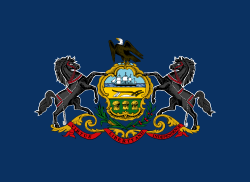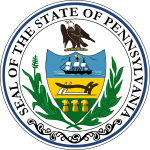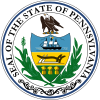
Back Pennsilvanië Afrikaans Pennsylvania ALS ፔንስልቬኒያ Amharic Pennsilvania AN Pennwudland ANG بنسيلفانيا Arabic ܦܢܣܝܠܒܐܢܝܐ ARC پنسيلڤينيا ARY بنسيلفانيا ARZ Pennsylvania AST
Pennsylvania
Pennsilfaani (Pennsylvania Dutch) | |
|---|---|
| Commonwealth of Pennsylvania | |
| Nickname: The Keystone State | |
| Motto(s): Virtue, Liberty and Independence | |
| Anthem: "Pennsylvania" | |
 Location of Pennsylvania within the United States | |
| Country | United States |
| Before statehood | Province of Pennsylvania |
| Admitted to the Union | December 12, 1787 (2nd) |
| Capital | Harrisburg |
| Largest city | Philadelphia |
| Largest county or equivalent | Philadelphia |
| Largest metro and urban areas | Delaware Valley |
| Government | |
| • Governor | Josh Shapiro (D) |
| • Lieutenant Governor | Austin Davis (D) |
| Legislature | General Assembly |
| • Upper house | State Senate |
| • Lower house | House of Representatives |
| Judiciary | Supreme Court of Pennsylvania |
| U.S. senators | John Fetterman (D) Dave McCormick (R) |
| U.S. House delegation | 10 Republicans 7 Democrats (list) |
| Area | |
• Total | 46,055 sq mi (119,283 km2) |
| • Land | 44,816.61 sq mi (116,074 km2) |
| • Water | 1,239 sq mi (3,208 km2) 2.7% |
| • Rank | 33rd |
| Dimensions | |
| • Length | 170 mi (273 km) |
| • Width | 283 mi (455 km) |
| Elevation | 1,100 ft (340 m) |
| Highest elevation | 3,213 ft (979 m) |
| Lowest elevation | 0 ft (0 m) |
| Population (2024) | |
• Total | |
| • Rank | 5th |
| • Density | 291.8/sq mi (112.7/km2) |
| • Rank | 9th |
| • Median household income | $73,800 (2023)[4] |
| • Income rank | 21st |
| Demonyms | Pennsylvanian Pennamite Pennsylvanier (Pennsylvania Dutch) |
| Language | |
| • Official language | None |
| • Spoken language | |
| Time zone | UTC– 05:00 (Eastern) |
| • Summer (DST) | UTC– 04:00 (EDT) |
| USPS abbreviation | PA |
| ISO 3166 code | US-PA |
| Traditional abbreviation | Pa., Penn., Penna. |
| Latitude | 39°43′ to 42°16′ N |
| Longitude | 74°41′ to 80°31′ W |
| Website | pa |
| List of state symbols | |
|---|---|
 | |
 | |
 | |
 | |
| Living insignia | |
| Amphibian | Eastern Hellbender |
| Bird | Ruffed grouse |
| Dog breed | Great Dane |
| Fish | Brook trout |
| Flower | Mountain laurel |
| Insect | Firefly (Colloquially "Lightning Bug") (Photuris pensylvanica) |
| Mammal | White-tailed deer |
| Tree | Eastern hemlock |
| Inanimate insignia | |
| Beverage | Milk |
| Dance | None |
| Food | None[6] |
| Fossil | Trilobite |
| Soil | Hazleton |
| State route marker | |
 | |
| State quarter | |
 Released in 1999 | |
| Lists of United States state symbols | |
Pennsylvania (/ˌpɛnsɪlˈveɪniə/ ⓘ PEN-sil-VAY-nee-ə, lit. 'Penn's forest country'), officially the Commonwealth of Pennsylvania[b] (Pennsylvania Dutch: Pennsilfaani),[7] is a U.S. state spanning the Mid-Atlantic, Northeastern, Appalachian, and Great Lakes regions of the United States. It borders Delaware to its southeast, Maryland to its south, West Virginia to its southwest, Ohio and the Ohio River to its west, Lake Erie and New York to its north, the Delaware River and New Jersey to its east, and the Canadian province of Ontario to its northwest via Lake Erie.
Pennsylvania was founded in 1681 through a royal land grant to William Penn, the son of the state's namesake. Before that, between 1638 and 1655, a southeast portion of the state was part of New Sweden, a Swedish colony. Established as a haven for religious and political tolerance, the colonial-era Province of Pennsylvania was known for its relatively peaceful relations with native tribes, innovative government system, and religious pluralism.
Pennsylvania played a vital and historic role in the American Revolution and the ultimately successful quest for independence from the British Empire, hosting the First and Second Continental Congress in Philadelphia that formed the Continental Army and appointed George Washington as its commander in 1775, and unanimously adopted the Declaration of Independence the following year.[8] On December 12, 1787, Pennsylvania was the second state to ratify the U.S. Constitution.[9]
In July 1863, the Battle of Gettysburg, fought over three days in and around Gettysburg, was the bloodiest and most decisive battle of the American Civil War, claiming over 50,000 Union and Confederate fatalities and repelling Robert E. Lee's invasion of the North, leading to the Union's preservation. Throughout the late 19th and 20th centuries, the state's manufacturing-based economy contributed to the development of much of the nation's early infrastructure, including key bridges, skyscrapers, and military hardware used in U.S.-led victories in World War I, World War II, and the Cold War.
Pennsylvania's geography is highly diverse. The Appalachian Mountains run through the center of the state, the Allegheny and Pocono mountains span much of Northeastern Pennsylvania, and close to 60% of the state is forested. Although it has no ocean shoreline, it has 140 miles (225 km) of waterfront along Lake Erie and the tidal Delaware River.[10]
Pennsylvania is the fifth-most populous state in the United States, with over 13 million residents as of the 2020 United States census, its highest decennial census count ever.[3] The state is the 33rd-largest by area and has the ninth-highest population density among all states. The largest metropolitan statistical area is the southeastern Delaware Valley, including and surrounding Philadelphia, the state's largest and nation's sixth-most populous city. The second-largest metropolitan area, Greater Pittsburgh, is centered in and around Pittsburgh, the state's second-largest city. The state's subsequent five most populous cities are Allentown, Reading, Erie, Scranton, and Bethlehem.[11]
- ^ "Symbols of Pennsylvania". Portal.state.pa.us. Archived from the original on October 14, 2007. Retrieved May 4, 2014.
- ^ a b "Elevations and Distances in the United States". United States Geological Survey. 2001. Archived from the original on October 15, 2011. Retrieved October 24, 2011.
- ^ a b "United States Census Bureau QuickFacts: Pennsylvania". United States Census Bureau.
- ^ "Household Income in States and Metropolitan Areas: 2023" (PDF). Retrieved January 12, 2025.
- ^ "Most spoken languages in Pennsylvania in 2010". MLA Data Center. Archived from the original on May 27, 2013. Retrieved November 4, 2012.
- ^ "United States of Food: Official State Foods". November 13, 2019.
- ^ Der Deutsche Pionier: Erinnerungen aus dem Pionier-Leben der Deutschen in Amerika ..., Volumes 3 to 5. 1871. p. 88.
- ^ Ellis, Joseph (2007). American Creation: Triumphs and Tragedies at the Founding of the Republic. New York: Knopf. pp. 55–56. ISBN 978-0-307-26369-8.
- ^ U.S. News | Best States | Pennsylvania
- ^ "General Coastline and Shoreline Mileage of the United States" (PDF). NOAA Office of Coastal Management. Archived (PDF) from the original on December 25, 2016. Retrieved December 31, 2016.
- ^ "U.S. Census Bureau QuickFacts". U.S. Census Bureau. Retrieved September 21, 2021.
Cite error: There are <ref group=lower-alpha> tags or {{efn}} templates on this page, but the references will not show without a {{reflist|group=lower-alpha}} template or {{notelist}} template (see the help page).

